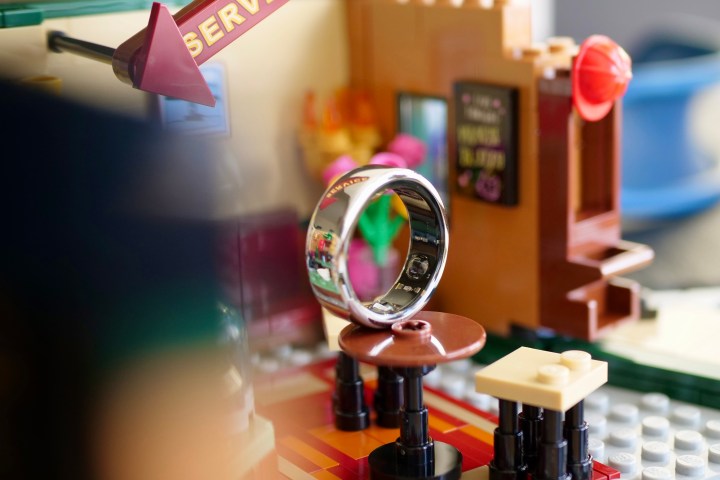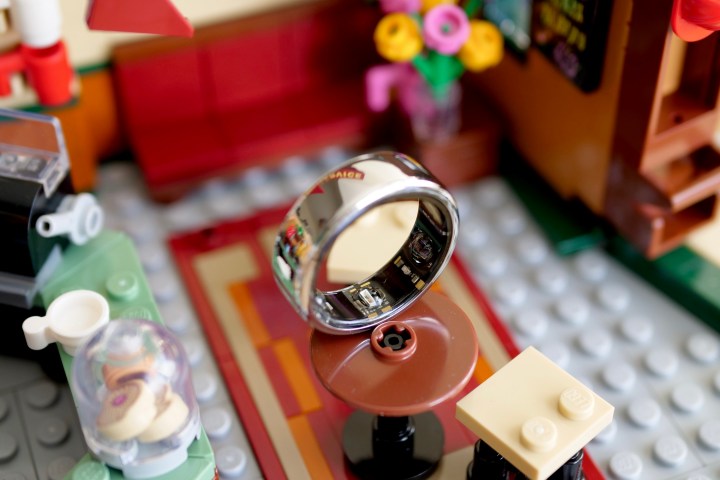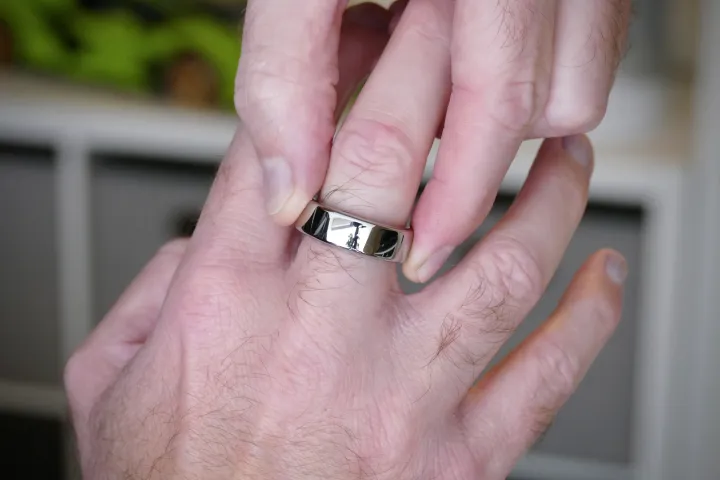I first put on an Oura Ring smart ring during the summer of 2021 and have used it continuously ever since. It remains the piece of wearable tech I have worn the most, and it’s unusual for a product to be this sticky.
But recently, I’ve started to question what the future holds for it. The answers I’m coming up with aren’t all that positive, and that’s making me wonder how much longer it’ll stay on my finger.
Why I love the Oura Ring

I want to start with why I still wear the Oura Ring. First, I love the way it looks. I recently changed to a silver version of the third-generation ring and think I prefer it over the glossy black version I had on before. It’s less noticeable on my finger, yet still glints in the sun. I find it immensely comfortable, it never becomes intrusive, and I can happily wear it 24 hours a day. That’s a lot more than can be said for some smartwatches. It has gathered some scratches and scuffs, though, and they show up more here than they do on the gloss black version, but less so than they did on the Stealth design I first tried.
Next, I love the Oura Ring’s reliability. It syncs without a problem, has never failed to record an activity or night’s sleep, and the data presented in the app is clear and understandable. It’s exactly what I want from a health-related wearable. I am also happy with the battery life, as six months into using the silver third -generation model, I still get about five days of use from it. However, I’m not so sure about how long the battery will keep up this performance. Digital Trends’ Mobile Staff Writer Christine Chan also wears a third-generation Oura Ring, and after a year, the battery in hers only lasts for about two days.
I like that I can still track health and activity when I wear a traditional watch, and how it never looks out of place or overly technical in nature. It blends in, but still attracts a fair amount of attention, too, with people often asking if it’s the Oura Ring and whether I like it. Until recently, I’ve always been very positive about it when I answer, stating how long I’ve worn it, how the sleep data is interesting and helpful, and how much I appreciate the good battery life. The only downside I used to mention is the subscription, which I still find very problematic. But now, there are other negative things creeping into my mind when I think about recommending the Oura Ring.
Oura’s got new (and limited) tricks

To understand what’s changing my mind, we need to talk about the Oura Ring’s features. Since I last wrote about wearing the Oura Ring in May 2022, both the blood oxygen (Sp02) monitoring feature and the workout heart rate tracking features have arrived — but only after being missing in action since the end of 2021 when they were announced.
Your Sp02 levels are monitored overnight, and the app shows the standard blood oxygen percentage figure, plus an overview about whether fluctuations in it may have changed your breathing. It’s informative, as the app does break down how critical any disturbances recorded are, but it’s difficult to understand what you should do about them. It’s also unfortunate that the option to have it operate all day isn’t available, even in a reduced capacity.
The workout heart rate tracking came in May this year and covers walking, cycling, and running, and shows maximum, minimum, and average heart rate. It also gives insight into how hard you worked, along with a map of your route if you exercised outdoors. It’s a handy (if basic) fitness tracking system that — when combined with sleep data — helps provide more insight into your daily readiness.
The Oura Ring app gives a clear picture of your general health on a daily basis. You can drill down to see more detail, including the heart rate information daily averages, restorative time, and detailed information about it when sleeping too. You can also see heart rate variability (HRV) data, but this is fairly complicated to interpret, as there are no simple baselines that apply to most people, unlike heart rate. I can see how my HRV fluctuates, but I have no real idea of whether this is a good or bad thing, and how to change (or not) if it is. The problem of not being able to easily interpret or act upon data collected isn’t unique to the Oura Ring, and it’s a complaint that applies to most health and fitness wearables.
While I’m pleased to see Sp02 and workout heart rate tracking arrive, they have been a long time coming, and Oura’s track record of slow feature releases hasn’t changed, because other previously announced features are still not ready. The more this happens, the less favorably I look at the product, and the more I am concerned about its future.
More features still to come — at some point

When Oura announced the workout heart rate tracking, it also said new workout options would be added over the coming months. But after six months, no others have arrived. A general workout mode can’t be that complicated to add in, and given that a lot of people may regularly do activities other than walking, running, or cycling (I know I do), it’s a pain not to be able to add them into the Oura app very easily.
These aren’t really solutions, as it’s hard to justify buying two wearables when one can, or should, do the job.
To overcome this, you can wear an Apple Watch, as the Oura app syncs with Apple Health or a Google Fit-enabled smartwatch to track other workouts. The Oura Ring also syncs with Strava, which fills in some gaps, but it’s still a platform focused on running, swimming, and riding — plus, it also needs another wearable. These aren’t really solutions, as it’s hard to justify buying two wearables when one can, or should, do the job.
Despite a November blog post talking about the similarly promised new sleep stage algorithm’s impending arrival, it’s still not out for my Oura Ring. In an email sent to Oura Ring owners, the company said the new sleep stages algorithm would arrive as a beta feature in the app, with the option to switch it on should you be invited to test it out. At this time, there doesn’t seem to be a predicted full, public launch date for the improved sleep stage tracking, which is a disappointment given the hype around it and the fact that it was used in the promotional material for the third-generation ring more than a year ago.
The slow pace of updates from Oura continues to frustrate. It’s an expensive product with a subscription package attached to it, and waiting for new features — with limited information on when they will actually arrive — isn’t something I expect and becomes less acceptable the more time passes. It also raises another, bigger concern. I’m still waiting for features to arrive that were announced last year, but more importantly, I also haven’t heard about what’s next at Oura. And that’s a different kind of problem.
Timelines — and the future

It’s pretty much a given that a new smartphone will have hardware alterations that facilitate new features and therefore prompt an upgrade, but there’s only so far Oura can go with the design of a ring, and only so many new sensors it can fit inside. What it does with those sensors and the software around it is Oura’s selling point. Oura charges a monthly subscription to continue seeing your data in its app, so it needs a clear road map for new features and software improvements to ensure there’s plenty of motivation to continue paying long-term.
But there isn’t one, and even if there was, would I trust any of the timelines? The answer is increasingly no, and the longer I wait to see already promised features on my Oura Ring, the less I’m going to believe any release windows for newly announced features. We’re now a year into the third-generation product, and unfortunately, with the missing features and no information on what the future holds, the appeal of paying out monthly for the Oura Ring diminishes.
With the missing features and no information on what the future holds, the appeal of paying out monthly for the Oura Ring diminishes.
When superb health and fitness products like the Apple Watch Series 8 and Apple Watch Ultra don’t have a subscription package attached, yet regularly receive meaningful feature updates, the Oura Ring leaves me feeling exasperated. I really like the hardware and do continue to find the app and its data helpful, but Oura’s heel-dragging is eroding confidence, and its silence on what I’ve got to look forward to is concerning.
My continued experience with the Oura Ring convinces me that smart rings have huge potential in health and fitness tracking, but it’s beginning to feel like it’s more the concept of smart rings I love. The Oura Ring is on my finger, but the company is at risk of me taking it off if it doesn’t fulfill my everyday needs, now and in the future. This is a serious problem because once someone takes a wearable device off, there’s a good chance it may not be put back on.
Editors' Recommendations
- One of the biggest Oura Ring competitors just did something huge
- I have Samsung’s newest cheap phone, and I’m a bit worried
- Here’s how you can try new Oura Ring features before anyone else
- The Oura Ring just got a lot more helpful if you’re pregnant
- I’m replacing my normal glasses with smart glasses. Here’s why




